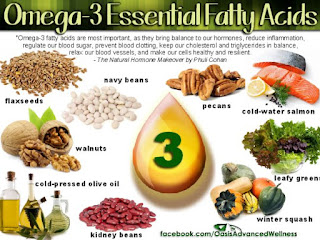UNSATURATED FATTY ACIDS
OMEGA - 3 ( EPA & DHA)
& OMEGA – 9 (Oleic acid)
OMEGA
– 3 (Polyunsaturated Fatty Acids)
Recent investigations have
found that the daily ingestion of a group of polyunsaturated fatty acids called
Omega provides great health benefits principally to the cardiovascular system.
It helps prevent problems of the cardiac and circulatory systems like
arteriosclerosis, high blood pressure, heart attacks and embolism. There are
other combinations of oils in this Omega group
named – Omega – 3 and Omega – 9.
One of the principal fatty
acids is Omega – 3 ( Linolenic acid) as well as Omega – 9 ( Oleic acid) which along with Omega – 3 have wonderful therapeutic
properties.
The Greenland Eskimos and the Pacific Northwest Groups, who
consume large amounts of fish, rarely develop coronary artery disease and have
a reduced risk of heart risks. The Eskimos have very low levels of LDL (Low
Density Lipoprotein).
It has been found that Eskimos and fishermen who eat a large
amount of fish have fewer heart problems, high blood pressure and cases of
cancer than people whose diet contains a high consumption of red meat. The
reason for this is the consumption of polyunsaturated fatty acids contained in
cold water fish and other marine animals.
Fish is rich in omega – 3; Flaxseeds are powerhouse of omega
– 3. Walnuts, sea foods, canola oil,
beans, cloves and dairy foods are also good sources of omega – 3.
Omega – 3 oil (Linolenic acid) is an 18 carbon long polyunsaturated fatty acid with three double bonds.
Linolenic acid is an Omega – 3 oil because its first double bond is at the
third carbon.
Linolenic
acid can be converted into eicosapentaenoic acid (EPA), which is the precursor
to the three series favorable prostaglandins. Prostaglandins of the series 1
and 3 are favorable while the same of the series 2 are no good. The reason is -
Prostaglandins of the 2 series promote
platelet stickiness, bad factor that contributes to hardening the
cardiovascular system. Another important omega – 3 oil is the DHA
(Docosahexaenoic acid).
 |
| Fish Oil |
Areas that
have been identified in which omega – 3 fatty acids change the metabolism:-
1 - They may lower blood pressure, a
major risk factor for heart attacks and stroke.
2 - They reduce the tendency for blood
platelets to stick together which can lead to formation of blood clots.
- They lower the rate at which the
liver manufactures triglycerides.
4 - They
may help repair the damage due a lack of oxygen in body tissues.
5 - They
are used for the treatment of depression associated with bipolar disorder.
OMEGA – 9 (Oleic acid)
It is
monounsaturated oil because it contains 18 carbons and one double bond at ninth
carbon molecule.
It has
proven effective in the reduction of cholesterol in people who live in
countries like Greece, Italy and Spain where olive oil is consumed daily in
meals.
A mix of
these fatty acids, Omega – 3 and 9 gives us a highly efficient combination for
the reduction of cholesterol and triglycerides, improving general health by
helping to:-
1. Reduce the risk of cardiovascular problems because it reduces cholesterol in the blood.
2. Avoid deposits of cholesterol on the arterial walls.
3. Reduce the level of triglycerides in the blood (fats that are strongly implicated in obesity, heart attacks and strokes).
4. Reduce the risk of thrombosis.
5. Helps to normalize blood pressure.
6. Eases symptoms of premenstrual syndrome.
7. Slows the advance of multiple sclerosis.
8. Slows the effects from the consumption of alcoholic beverages.
9. Slows the growth of cancerous tumors.
10. Increases the mobility of blood cells.
11. Helps avoid blood clots, making platelets less sticky.
12. Prevents the development of rheumatoid arthritis.
13. Helps to combat skin disorders like Psoriasis and Eczema.
1. Reduce the risk of cardiovascular problems because it reduces cholesterol in the blood.
2. Avoid deposits of cholesterol on the arterial walls.
3. Reduce the level of triglycerides in the blood (fats that are strongly implicated in obesity, heart attacks and strokes).
4. Reduce the risk of thrombosis.
5. Helps to normalize blood pressure.
6. Eases symptoms of premenstrual syndrome.
7. Slows the advance of multiple sclerosis.
8. Slows the effects from the consumption of alcoholic beverages.
9. Slows the growth of cancerous tumors.
10. Increases the mobility of blood cells.
11. Helps avoid blood clots, making platelets less sticky.
12. Prevents the development of rheumatoid arthritis.
13. Helps to combat skin disorders like Psoriasis and Eczema.


No comments:
Post a Comment